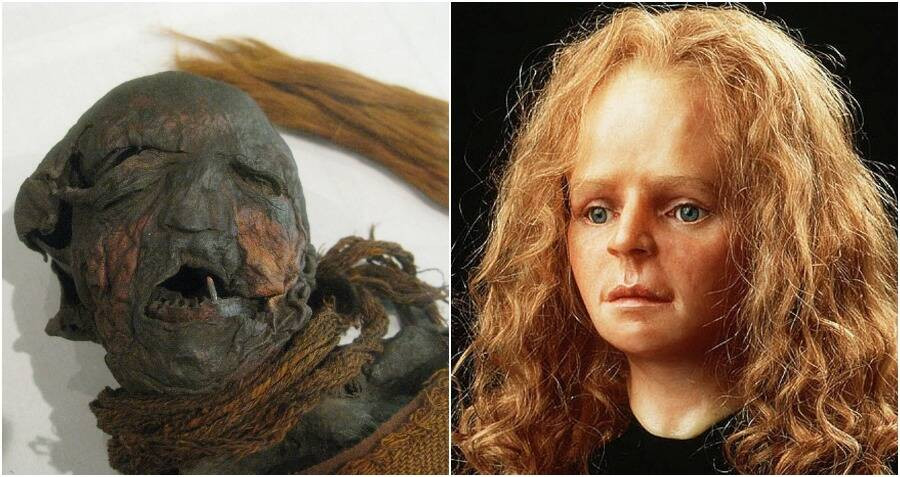In the spring of 1897, the quiet village of Yde in the Netherlands became the unlikely epicenter of an archaeological revelation that would capture the attention of the world. Two laborers, performing the mundane task of dredging peat from the Stijfveen swamp, stumbled upon something extraordinary: the remarkably preserved remains of a young girl. Her fiery red hair and the condition of her body, eerily intact despite the passage of millennia, would spark fascination and debate among scientists, historians, and the general public for over a century.
Piecing Together the Puzzle: A Body Frozen in Time
When local authorities and the Drents Museum were alerted to the discovery, they were met with a sight as unsettling as it was mysterious. The girl’s body bore signs of violence and trauma. A noose encircled her neck, hinting at strangulation, while a significant wound near her skull suggested a brutal blow. Her limbs were not in their natural positions, and only part of her once-vibrant hair remained, with half shorn away. To add to the enigma, her teeth were missing, raising questions about the events that led to her tragic demise.

The remarkable preservation of her body was due to the unique conditions of the peat swamp, where the high levels of tannic acid acted as a natural preservative. These factors ensured that the girl’s remains endured the passage of time, providing an invaluable window into a distant and mysterious past.
Modern Science Unveils Ancient Secrets
For decades, the identity of the Yde Girl and the circumstances surrounding her death remained speculative at best. However, the advent of modern technology, particularly radiocarbon dating and advanced imaging techniques, offered groundbreaking insights. In 1992, a CT scan conducted by Professor Richard Neave brought a clearer picture to light. The scan revealed that the girl had lived approximately between 54 BCE and 128 CE, making her remains over two thousand years old. Furthermore, it showed that she was about 16 years old at the time of her death.
The scan also uncovered details about her physical condition. The girl had a spinal deformity, likely scoliosis, and an abnormal foot that would have caused her to walk with a limp. These discoveries deepened the intrigue surrounding her life and death, hinting that her physical attributes might have played a role in her ultimate fate.
Theories and Speculations: Ritual Sacrifice or Punishment?
The circumstances of the Yde Girl’s death have fueled a wide range of theories. Dr. Roy van Beek of Wageningen University put forth two prominent possibilities: that she was either executed as a criminal or sacrificed in a ritualistic ceremony. The location where her body was discovered—about a kilometer from the nearest settlement—has been a key factor in supporting the ritual sacrifice theory. In ancient cultures, wetlands like the Stijfveen swamp were often considered sacred spaces, associated with offerings to deities.
The noose around her neck and the missing teeth have been interpreted as indicators of a sacrificial ritual. Rituals involving human sacrifice were sometimes performed to appease gods or ensure prosperity, particularly in agricultural societies. The girl’s physical deformities might have marked her as “special” or “chosen” in the eyes of her community, making her an ideal candidate for such a ritual.
A Personal Tragedy? A New Perspective Emerges
In 2019, Dr. Van Beek and his team revisited the Yde Girl’s story, proposing a more personal interpretation. They speculated that her death might not have been solely an act of communal sacrifice or punishment. Instead, it could have been driven by deeply personal motives within her community. The researchers suggested that her physical abnormalities, while setting her apart, might have subjected her to social stigmas or beliefs that viewed her as an intermediary between the natural and supernatural worlds.
These characteristics, coupled with the religious and cultural beliefs of the time, might have led to her selection for sacrifice. The act, while horrific by modern standards, could have been seen as a noble or necessary offering to ensure the community’s survival and prosperity. Such a perspective underscores the complexity of ancient societies, where religion, superstition, and social dynamics intertwined.
The Legacy of the Yde Girl
Today, the Yde Girl’s mummified remains are housed in the Drents Museum in Assen, Netherlands, where they continue to fascinate visitors from around the globe. Her story has become a poignant reminder of the enigmas buried beneath the earth, waiting to be uncovered. For many, the Yde Girl symbolizes the enduring connection between humanity’s past and present, offering lessons and provoking questions about our ancestors’ lives, beliefs, and practices.
Advances in science have allowed researchers to uncover remarkable details about her life and death, but many questions remain unanswered. What led to her tragic demise? Was she a revered figure in her community, chosen for a significant sacrifice? Or was she a victim of societal fears and prejudices? These mysteries keep her story alive, drawing scholars and enthusiasts alike to seek further understanding.
The Yde Girl’s legacy is not just one of tragedy; it is also a testament to the resilience of human history. Her preserved remains offer a rare glimpse into an ancient world, reminding us of the fragility of life and the complexities of human societies. As science and technology continue to advance, new discoveries may shed further light on her story. Yet, some aspects of her life and death may remain forever shrouded in the mists of time, an eternal enigma that binds us to our distant past.





